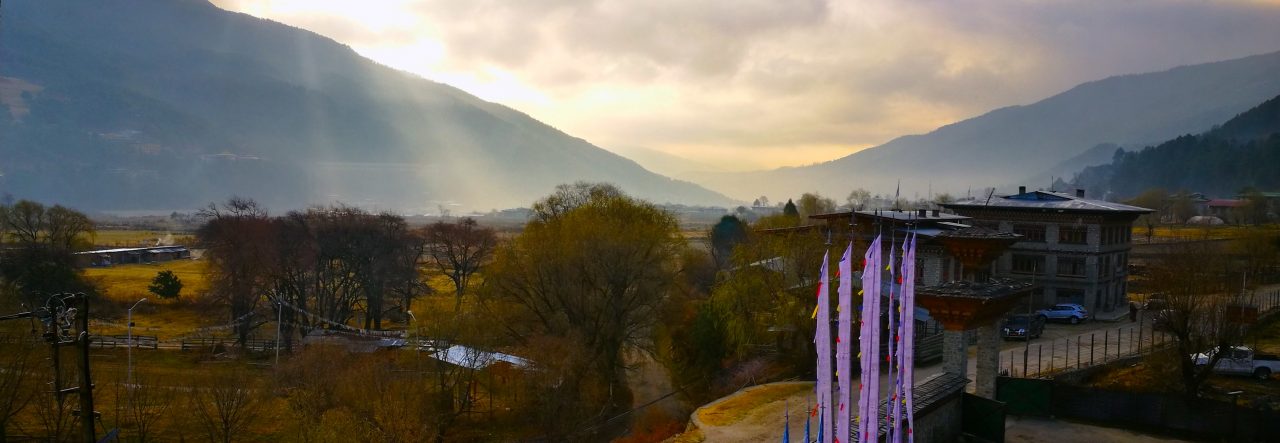It was late October 2002. I was with the Bhutan Broadcasting Service then.
With my cameraman, Sonam Loday, and soundman, Tshering Norbu, we were on the last day of our trek to Singye Dzong. After our lunch break we thought we had got closer to our destination and so we sent our guide ahead. We have been filming along the way, since we left our camp in Thangkarmo, and we continued to do that day too – which actually slowed our progress.

Then the Sun was almost at the horizon when we realized that we were nowhere near our destination. We packed our gear and zoomed off. I started worrying but managed to hide it from my two younger colleagues. The trail was never ending. Did we miss our path? We were told that at the intersection of Doksum, we should take the valley to the left, which we did. The one to the right would have taken us to another valley – Rongmateng.
Late afternoon turned into evening, which also gave way to the darkness. And still no sign of inhabitation or religious sites whatsoever. Usually they are marked with prayer flags or chortens. Nothing except dense jungle and total darkness made creepier by a furious sound of the river gushing below us. We kept going. My two colleagues followed me. They thought I knew the way. But I was already panicking. We were warned from Khoma not to undertake the journey for it was late autumn and the yak herders would have already left for lower valleys. In fact it was our second day that we had not met any soul. Did I push too far? Did I put the lives of others at risk? My heart started pounding even faster because of such thoughts. I was breathing faster and because of pantings and hyperventilation I was getting dizzy. My vision was getting blurry. We slowed down and I said to myself, “If we don’t get to our destination in another 10 minute I am as good as dead.”
Then as we turned around a corner I thought I head some prayer flags fluttering in the darkness. Was I hallucinating? I stopped and I pointed my flashlights. There besides a string of worn-out prayer a flag was a small rock carving of Guru Padma Sambhava and a marker, ‘Way to Singye Dzong’. “Yes!” I thought. “We are on the right track. Thanks, Man. You save my life” I silently told Guru. We stopped, dropped our loads and I took out my small towel from my bag and covered my face. Out of sheer joy and relief, I cried silently. It was dark and so we couldn’t see each other’s faces. We could only hear gasping for air from the brisk walk and from the very high altitude we were already at. With my energy recharged, literally, an hour later, at close to midnight, we reached our campsite.
During our week-long stay in that area we saw nothing but rocks and caves. There is actually no dzong in Singye Dzong. Dzong is a metaphor. Every ancient Dzongkha word, I was told, has three meanings – the outer, which we are all familiar with, the inner and the secret. It is called chi nang, saang. The nang meaning of dzong is “a peaceful place” – a sanctuary. In fact the place is so peaceful and exudes an energy that you can feel right to the core of your heart.

I am sharing this story in light of a recent news report that rock carvings of religious figures would be banned in Bhutan. I hope that people who make such decision will also read my story. Had it not been for that small rudimentary work of rock art, which are now being termed as religious desecration, I wouldn’t be alive or I would be telling a different story.
The presence of the sacred and the spiritual energy is found both outside and inside the temples. While others may not have such a dramatic story like mine, I have had friends who visited Bhutan and felt powerful the energy everywhere. The presence of a chorten here, a rock carving there, water-driven prayer wheels in a distance and prayer flags everywhere, exude energy like nowhere else. Hence, I am not sure how these things are sacrilegious. Do we really need to regulate them? Shouldn’t we be actually encouraging such religious pursuits?
Just asking.



